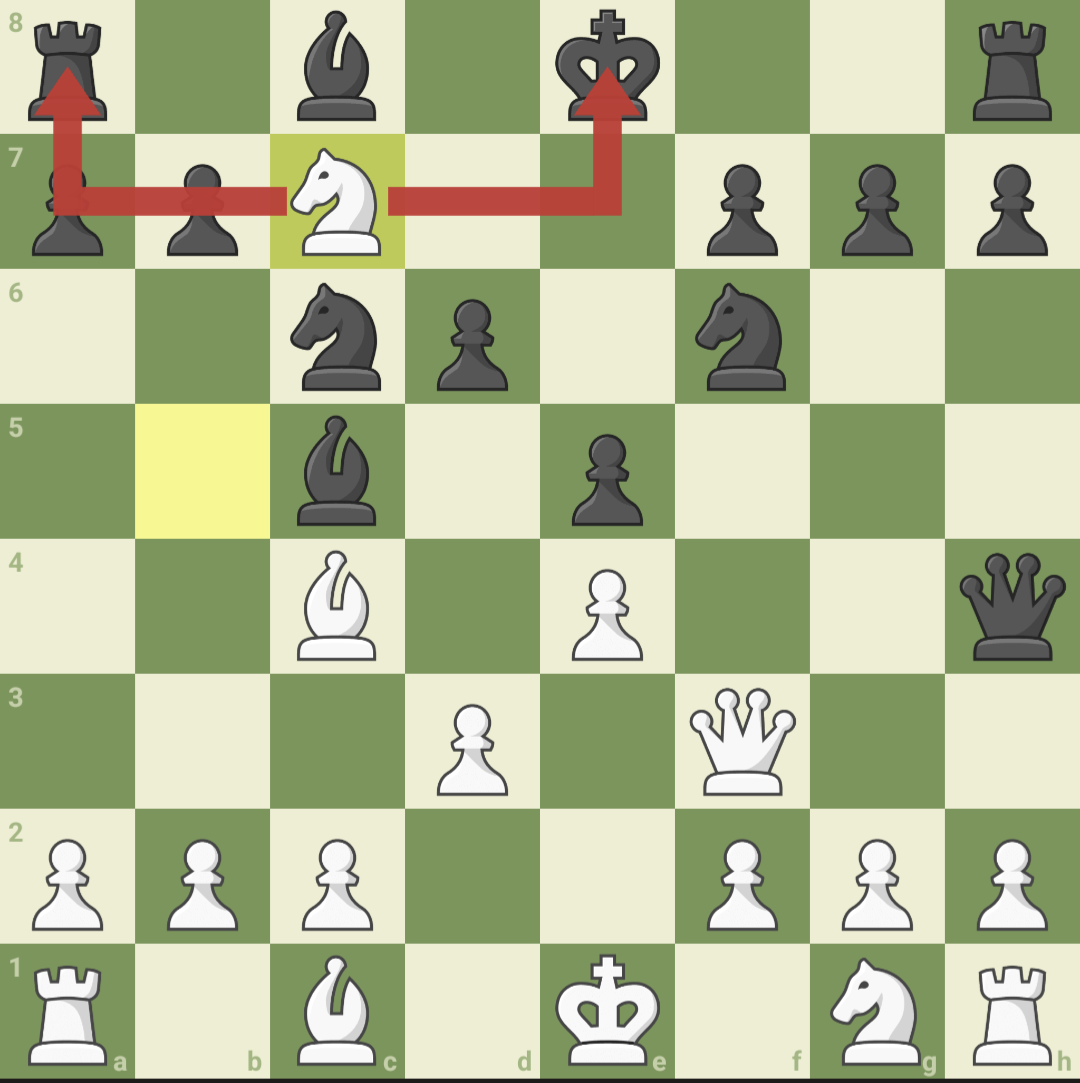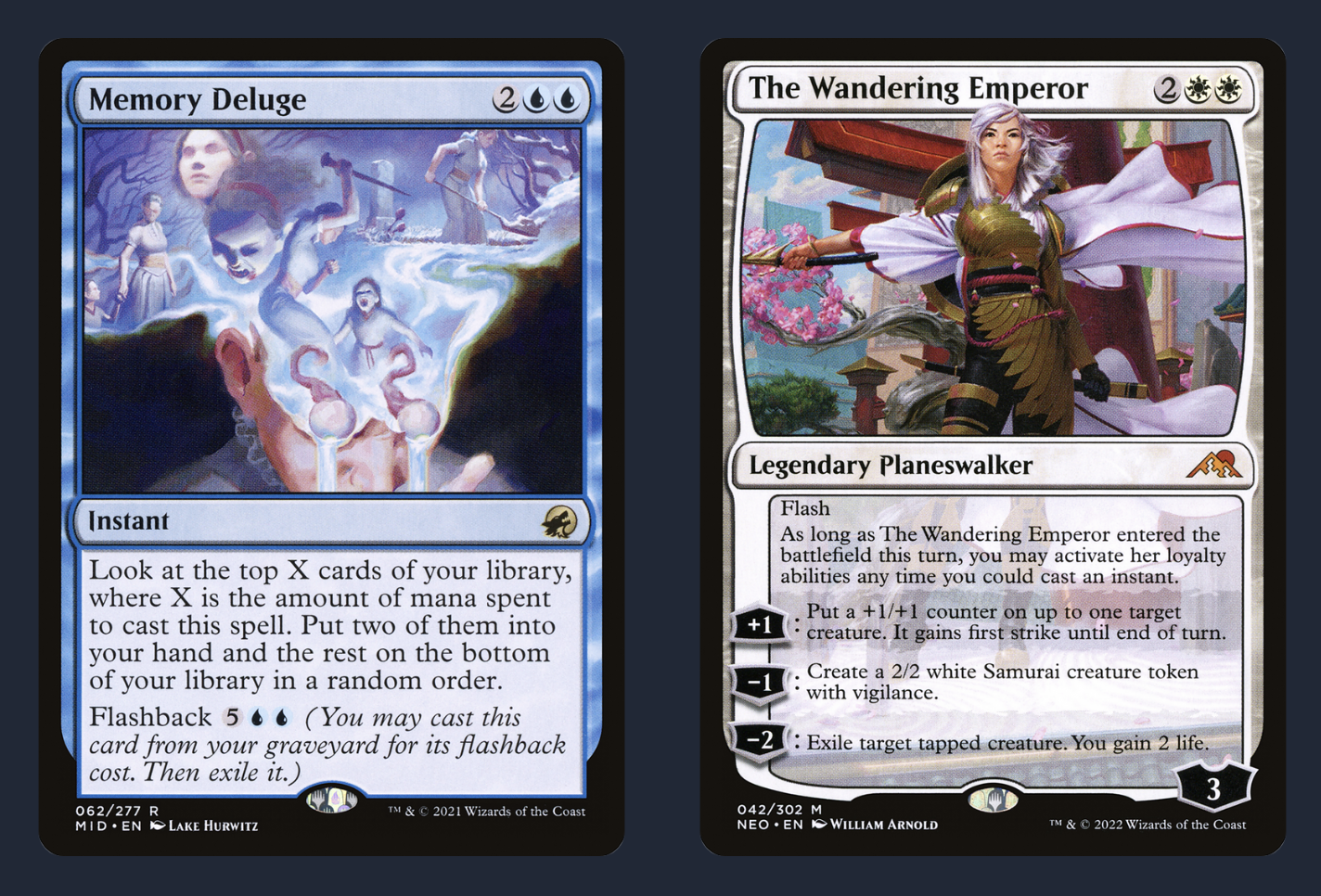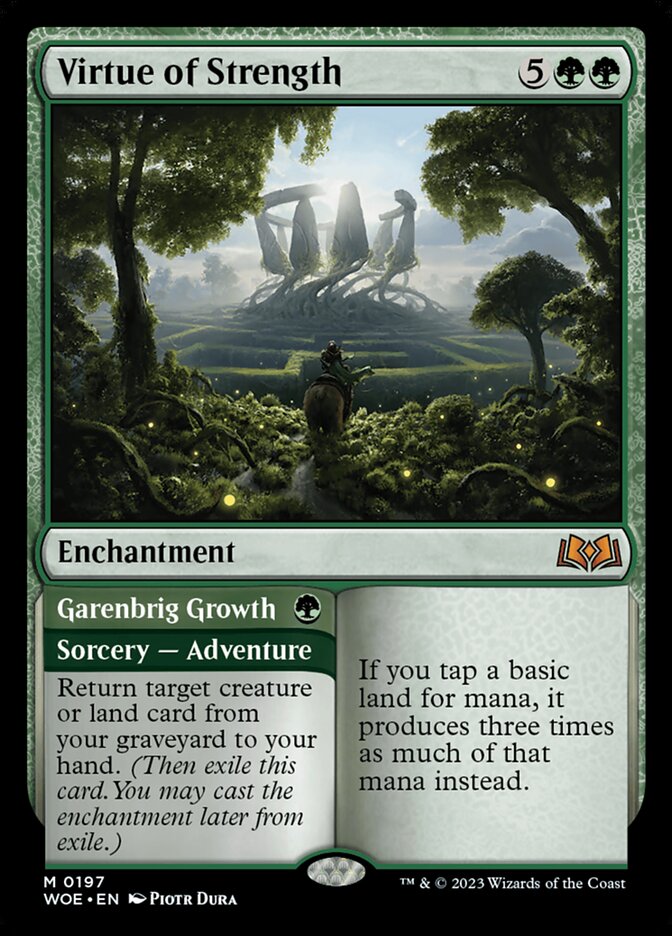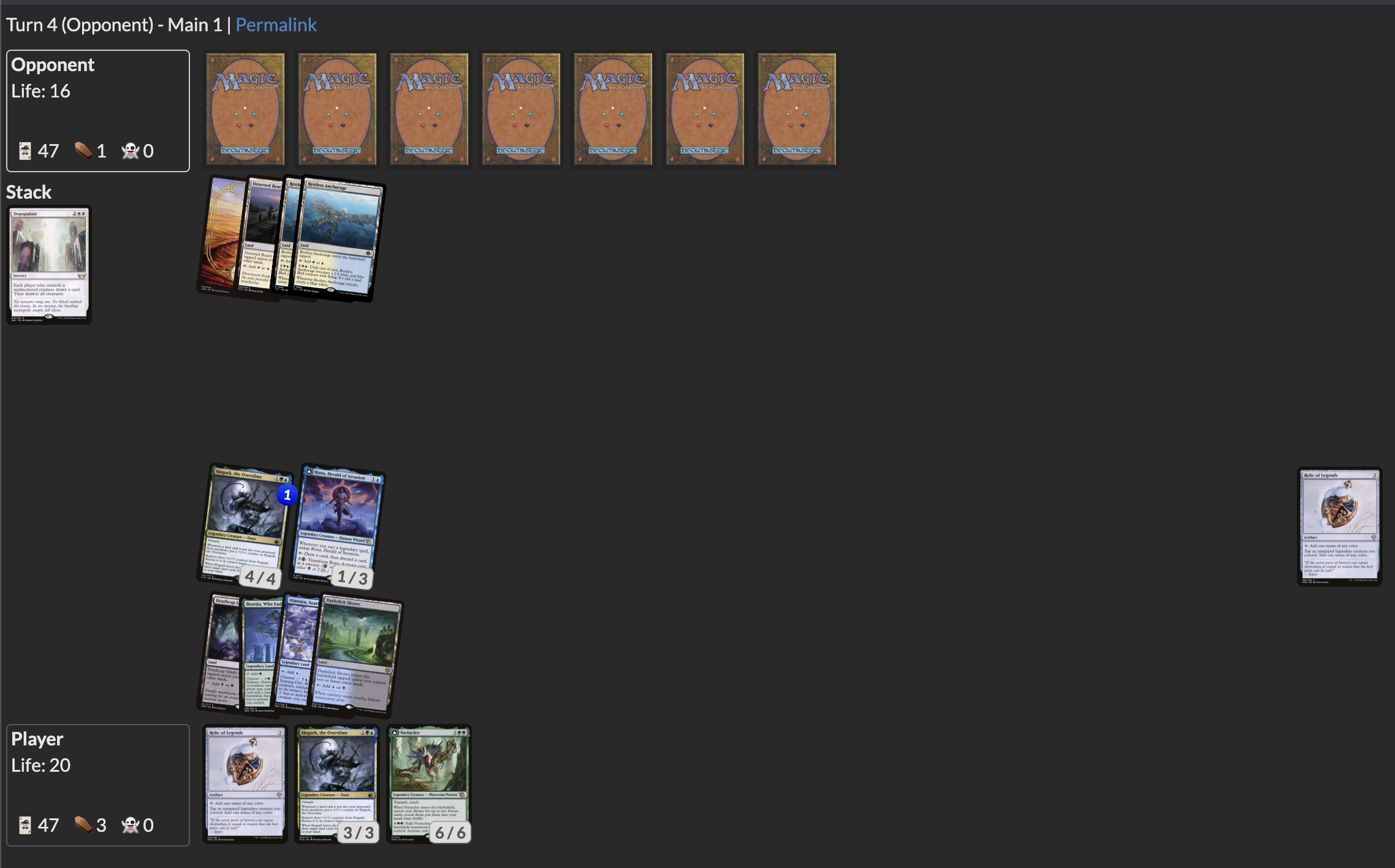Forks: A Theory of Threats and Answers
05/24/2024
Last week, I posted the following meme to Twitter:

I refused to explain what exactly the joke was, instead claiming that I'd probably write an article about it at some point.
So I guess this is that article! Today, you'll learn why I think that
Virtue of Strength when cast by Temur Analyst against UW Control is very similar in gameplay texture to the pair of Memory Deluge and The Wandering Emperor that Control itself often leverages, and how that relates to gameplay with and against Control in general.Part 1: What is a Fork?
The term "fork", as it is used in strategy games, comes from chess. The concept is fairly simple: you make a move that threatens two pieces at the same time. As the nature of chess is that you can only move one piece per turn, it's then naturally fairly hard for your opponent to answer both threats at once - they can save one piece but in doing so will lose the other.

A classic knight fork: the white knight on c7 is attacking both the black rook on a8 and the black king on e8. Since the king is in check, it must move out of check - thus allowing the knight to capture the rook, giving white a huge advantage.
Of course, this concept doesn't completely translate to Magic - the games are very different, with Magic having a lot of hidden information, not having a one-move-per-turn restriction, and having a more complex concept of "threats" and "answers".
But the core idea can still apply! At its essence, the idea of a fork is simply that you are presenting two threats at the same time, in such a way that your opponent cannot effectively deal with both - thus making it so that one of your threats comes to fruition and produces an advantage for you in the game.
The Classic UW Control Fork

the bane of Standard and Pioneer players deciding whether to attack with a non-vigilant creature
Since their printings in MID and NEO respectively,
Memory Deluge and The Wandering Emperor have become a backbone of UW Control in both Standard and Pioneer. Both have proven to be very powerful, checking all the boxes of: being high-rate, playing well to a controlling gameplan, and most notably complementing each other extremely well.The fact is, when your UW Control opponent passes with 4 mana up, the nature of hidden information puts you in a bit of a fork: even if they don't actually have both Deluge and WEmp, they're certainly threatening both. And many decks have a hard time dealing with both at the same time!
For example, the common question at this stage is: do I attack into a possible Wandering Emperor? Getting your creature exiled can be pretty bad, especially if it's something valueable like
Gix, Yawgmoth Praetor or Glissa Sunslayer. It's even worse if they can simply make a Samurai to trade with or eat your creature.But if you don't attack, you're just giving the UW player more time to possibly cast a Deluge in order to perfectly shape their hand and setup for the long game. Attacking opens up a clean window for WEmp to get value, but not attacking opens up more breathing room to resolve card draw like Deluge.
Of course, this is a weirder fork than many that occur in chess, since the hidden information part of it means that sometimes the correct threat doesn't actually materialize! But even if they don't have either, the opponent is still put in a bind - and that's the power of a fork.
Forking Over Mana
UW is not the only deck that plays with forks. The Standard Analyst combo deck, for example, also has a very specific kind of fork that helps it push through countermagic -
Virtue of Strength.
The situation often plays out as follows: Analyst often can put many many lands into play, assembling a huge mana advantage. But even with all 16 of their basics on the battlefield, sometimes they can struggle with doing 2 relevant things in the same turn - a lethal
Worldsoul's Rage will often take all of their mana, if not even more mana than they have; and casting Memory Deluges for card advantage, while doable, is still somewhat expensive.So when playing against a Control deck that has lots of hard countermagic with cards like
Three Steps Ahead, just casting large Worldsoul's Rages can be too slow for a kill, and liable to run out of cards quickly. This is where Virtue comes in.Against Control, the fundamental purpose of Virtue is to bait out counterspells. And this almost always works, because Virtue is at its core somewhat of a fork!
If a Control deck lets Virtue resolve, it often means that Analyst gets to immediately double its mana - 16 lands uses 7 to cast Virtue, leaving the remaining 9 to tap for 27, almost double the 16 mana that you started with. And if that happens, suddenly Analyst can actually start casting up to 4 or 5 very relevant 7+ mana spells each turn. In this sense, the Virtue represents a threat to take the mana advantage a notch higher, from merely advantageous to absolutely game-winning.
But at the same time, if Control counters Virtue, that's another counterspell not spent dealing with Analyst's card draw and actual kills. Spending a valuable counterspell on Virtue just increases the threat Control faces from being run out of relevant cards.
This fork is made even more explicit when it exploits Analyst's mana advantage by being applied when UW is low on mana - if UW has many counterspells in hand but only one available to cast, Virtue becomes even more devastating. Then, the Virtue itself threatens to push out two threats that can't both be countered; and if the Virtue is countered then that threatens to open a window where UW is tapped out that lets the Analyst player resolve a card draw spell or combo piece.
Part 2: Creating Forks
So why should we care about forks as a concept? The examples I've given certainly aren't new play patterns - it's pretty well-known that multiple distinct flash threats convey advantages of hidden information and being able to utilize reactivity to deploy the right threats and answers; and it's pretty common to talk about "bait spells" when playing against countermagic. In what way is grouping all of these play patterns together under "forks" useful?
Well, personally I find this framing useful because I find it to be a very nice framing through which to think about the more general concept of threats and answers. This is why I keep bringing up examples involving Control - the whole conceit of Control is to be a deck primarily focused on answering your opponent's threats, so it makes sense that forks would come up quite a lot there.
The point is less categorizing these well-known situations - multiple flash threats and bait for counterspells - as forks, and more recognizing when you can use a fork to efficiently play around your opponent's answers.
Find the Constraints
One of the key components of a fork is that it requires two threats that your opponent can't both answer, or at least struggles to answer both of.
So, a very natural way to go looking for forks is by asking: what's a bottleneck in the answers your opponent can have? What can you push on such that your opponent doesn't have the resources to do two different things at once?
Taxing Mana
The most common point here is, of course, mana. Unlike in chess, there's no hard one-move-per-turn limit - but there still is the restriction of having to pay mana for your spells! So, often one way to present a fork is just as simple as playing two threats in the same turn.
Of course, there are many ways around this. Some answers, like
Go for the Throat, are cheap enough that it's pretty easy to double-spell with two to answer two threats. In fact, creature removal especially often trades up on mana, making it hard to push creature-based forks through on the basis of just mana.And of course, the classic way that control decks sweep up multiple threats at once is, well, sweepers. Playing 10 creatures to the board as threats won't constrain mana at all if they can all be answered with a single
Sunfall.But of course, there are ways to threaten your opponent that aren't just the threat of creatures on the board! There are many other axes on which to threaten gaining advantage.
One example that's been coming up quite a lot for me recently is the card
Vorinclex in Slogurk, and its play patterns specifically in the UW Control matchup.Now you might think that Vorinclex isn't that good against control - after all, it costs 5 mana, and doesn't really develop Slogurk's main synergy plan directly, even if it does help you hits some land drops. Specifically the 5 mana seems like it could be a sticking point; it does feel quite good if it resolves, but can you really resolve it that often?
It turns out the answer is actually yes, through careful use of forks! Specifically, when I have a Vorinclex in my hand in the early game, I'll often try to push the UW control player into tapping out for Sunfall. This isn't that hard - often simply having two of [Rona, Inti, Slogurk] on the battlefield at the same time is enough to force Control's hand. And when they do inevitably tap out for a wrath, that gives me a window to resolve Vorinclex, immediately drawing two cards, hitting my land drops, and presentin yet another threat that the opponent is now even less equipped to deal with.

the threatening board / vorinclex in hand fork in action
This is one of the reasons why I find the Slogurk vs UW Control matchup so favorable for Slogurk - inherently, Slogurk is extremely good at setting up forks of threatening enough on the board to force Control to tap out for a clunky answer like Sunfall; while also then threatening to immediately re-develop and push on Control to continue to tap out and fall behind as each answer costs more than they can afford.
For a perfect example of what I mean, see this game in full.
Choking Cards
The other natural resource to attack is of course cards in hand. Sometimes, the opponent just doesn't have that many cards that can answer your threats, either in hand or even just in their deck. So if you pressure them to use a premium answer on one threat, then that's one fewer answer for your other threats.
Baiting counterspells often fall into this category. Of course, sometimes your bait spell will exploit mana to create a fork - if your opponent only has enough mana for one counterspell, for example, and you can threaten to cast two things. But even if you have to tap out for your bait spell, you can still fork your opponent on cards, as the counterspell they spend will still not be available for your second threat.
Strategic Forks
Many forks function on a tactical level, as individual gameplay decisions to take advantage of specific scenarios in a game. But you can also think about building an entire deck to center strategically around forks by presenting multiple distinct gameplans that each punish the opponent for answering the other gameplan.
Pioneer Amalia, for example, is completely built around the idea of a fork between combo and beatdown. In that deck, the threat of combo is great enough that your opponent often must spend quite a few resources dealing with it - and this often includes paying life as a resource, in order to pay for the Ward trigger on
Amalia. Then, when your opponent does sink a bunch of resources into dealing with your combo threat, you can enact the other half of your fork: a somewhat anemic beatdown plan, but one that is greatly augmented by you having forced an answer to your combo plan.In fact, many creature combo decks utilize a gameplan like this. Yawgmoth in Modern is another prime example, as is Slogurk in Standard. Compared to something like Pioneer Lotus, these three decks all have combo plans that are much weaker and more interactable - but they make up for it by forking the opponent between that combo threat and a fair plan to boot. Lotus's one-dimensional gameplan can completely fold to targeted combo hate like
Damping Sphere, but a deck like Slogurk can easily punish the opponent for daring to spend a card and 2 mana on Rest in Peace.Part 3: Breaking Out of Forks
Unlike in chess, forks in Magic are never so simple as a forced king move leaving your queen to be captured - there are often things you can do to avoid or wiggle out of them!
One way to avoid forks is to simply have more flexible answers that help you get through various kinds of constraints. The cheaper you can answer your opponent's threats, the less likely they're able to tax your mana; and the more answers you have that can actually interact with them, the less likely they can run you out of those answers.
But beyond simply "having better cards", there are other gameplay patterns you can play to as well.
Zwischenzugs
The zwischenzug - or intermediate move - is a chess term you're less likely to have heard of. It's a bit more complicated than a fork, but plays with similar ideas of threats and answers, in a way that can still be translated into Magic.
This time, instead of threatening two things at once, the idea is that you answer an opponent's threat not with your own immediate answer, but instead with a more pressing threat of your own! Then, while your opponent is dealing with your threat, that can buy you time in a way that puts you in a better position to answer your opponent's original threat.
My favorite example of this is
Jace, the Perfected Mind.Consider the following scenario: you're playing UW Control, and your opponent has played two creatures out onto the board. The two creatures represent enough pressure that they don't really need to commit anything else from their hand - in some senses, they're presenting a fork of forcing you to tap out and wrath so that they can then freely develop the bigger and more impressive threats they've left behind.
But instead of playing into their fork and wrathing, you cast a copy of Jace, and uptick on one of their creatures. Now, their pressure has lessened by quite a bit - while both creatures are still on the board, only one can deal damage. Plus, if they try to attack you then they're letting the Jace continue to plus and work towards more value from its -2 card draw ability.
So now they kind of need to continue developing more threats - they could choose to sit back and slowly work at killing Jace, but that just gives you more time to develop yourself as well. So they cast a third creature, hoping to get the Jace off the battlefield.
Of course, this is exactly what you were waiting for - you now get to untap and wrath the board, and you now have a Jace left to generate future advantage as well! You've successfully dealt with their fork by forcing them to overcommit to the board, all while actively improving your position.
Of course, any single-target removal spell could also have incentivized them to play a third creature to keep up the pressure. But that would only have delayed the game, not really progressing anything or giving you any advantage. Jace uniquely benefits you in this way, as even though its "removal" uptick mode isn't truly permanent removal, it functioned well enough to still cause the overextension, while leaving you actively ahead after a wrath instead of at parity.
This is the power of an in-between move - they aren't as common as forks, but when they work they can be even more devastating.
Conclusion
As I've been playing more constructed and specifically more control matchups in constructed, I've started seeing forks everywhere. Knowing how to play with and around them is key to understanding how best to leverage both threats and answers, and is an extremely important part of good Control theory.
I could certainly go on and on about more examples of forks - but I don't have the time, and I don't think it would be that productive to just talk about 20 different Slogurk positions. But I hope that what I've laid out here is enough to show the power of forks, and give you an idea of what to look out for.
#FreePalestine | Consider donating to UNWRA or PCRF, supporting protesters locally, and educating yourself.
